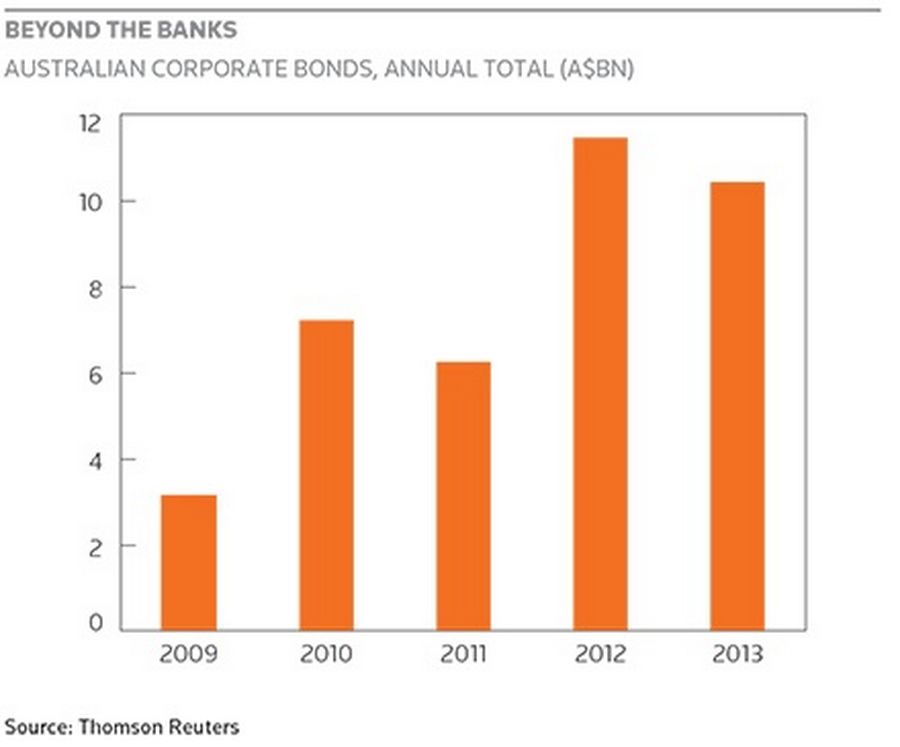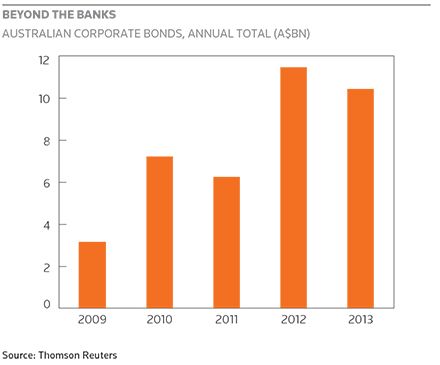Australia’s fixed-income market grew strongly in 2013 amid a benign outlook for base rates, but a slow start to 2014 shows that global volatility remains a threat to growth.

Search for stability
Source: REUTERS
A bystander wearing warm clothing during winter stands on the edge of a saltwater swimming pool to watch surfers try to catch a large wave at Dee Why Point on Sydney’s north shore.
Further growth in the Australian bond market in 2014 depends on a favourable global backdrop, which may not be forthcoming if January’s emerging-market wobble is any guide.
Wary of the potential volatility, some issuers have already pre-funded bonds maturing later this year, while other frequent issuers are expected to be less active in the local market, according to Paul White, global head of syndicate at ANZ.
“The market is likely to be more challenging in 2014 with more volatility expected,” White said.
That may be disappointing after a strong 2013. Aussie dollar bond issuance, for instance, picked up significantly last year with A$133bn (US$108bn) printed overall, up from A$107bn in 2012 and A$114.8bn a year earlier.
The upturn reflected a near doubling in securitisations (mainly residential mortgage-backed securities) to A$31.6bn, as well as state governments’ increased use of the syndicated market to meet their funding requirements.
A narrowing in spreads on RMBS and other asset-backed securities in 2013 – on the back of rising domestic and overseas demand for higher yielding Triple A rated assets – inspired the upturn in issuance as an increasing number of banks returned to the secured segment.
Syndication desks are certain that this revival will continue unless spreads blow out again and Treasurers switch to cheaper funding in the senior unsecured and covered bond markets.
One reason for confidence is that the Australian market is partially decoupled from the rest of the world and, as such, is inclined to be relatively steady in volatile times, according to White.
“During such periods, domestic investors tend to look closer to home and, with the domestic yield curve still steep, we will continue to expect to see plenty of demand for duration and credit,” he said.
Banks looking offshore
Given the large amount of government-guaranteed bonds maturing this year, bank issuance in the domestic market will, all things being equal, be expected to surpass the annual total of about A$35bn seen each year from 2011 to 2013.
However, a higher proportion of the funding needs of the country’s four major banks may well be met abroad, where relative pricing levels have become more competitive.

Beyond the banks
Together, ANZ Banking Group, Commonwealth Bank of Australia, National Australia Bank and Westpac Banking Corp sold more than A$10.5bn-equivalent in US dollars, euros, Swiss francs, sterling, Samurais and Australian dollar Eurobonds in January 2014 and nothing at home.
In comparison, during the same month in 2012 and 2013, the four raised A$7.1bn and A$4.3bn locally and A$6.1bn and A$8.3bn overseas, respectively.
European issuance has rebounded on the back of a much improved cross-currency basis swap, which makes euro transactions viable once again. Furthermore, the US dollar market, which accounted for 42% of all major bank supply in 2013 and almost 60% of overseas issuance, became even more compelling in early 2014.
This year’s first two benchmark US dollar deals, from ANZ and Westpac, priced flat to or inside the majors’ domestic curves, a highly unusual outcome given the demand for these issuers at home.
Down credit curve
Australia’s underutilised corporate bond market is expected to grow further in 2014 after a busy 2013 as more low-investment-grade corporations find willing buyers for their bonds.
Last year, 34 Australian companies from outside the financial sector, including eight debutants, tapped the local market for a total of A$10.4bn.That was just short of 2012’s record corporate supply of A$11.4bn, but well above historical volumes. (See Chart.)
There is plenty of room for improvement. Supply from corporations represents just 7.5% of total Aussie dollar bond sales, well below the 20%-plus share of the asset class seen in other markets. Financial issuers still dominate Australia’s markets.
While larger corporations, including multilateral blue chips like BHP Billiton and Rio Tinto, focus on the much deeper US and euro markets, strong demand from domestic investors hungry for yield and scarce corporate paper, should persuade more Triple B rated companies to issue longer-dated deals.
Last year, 18 corporations printed local seven-year bonds in 2013 to raise a total of A$4.4bn. Eight of these corporate issuers had Triple B ratings and three others had split Triple B and Single A ratings. This compared with eight seven-year corporate issues in the whole of 2012, all of which came from companies with ratings of at least Single A.
This journey down the credit spectrum is not without risks, however, as Qantas Group underlined at the end of 2013 when Standard & Poor’s and Moody’s downgraded the carrier’s ratings to junk status.
Qantas issued its only outstanding domestic bond on April 22 last year, a 6.5% seven-year issue, which tumbled sharply as a result of the downgrades.
The loss of investment-grade ratings can trigger forced selling among Australia’s institutional investors, most of which have mandates preventing them from buying high-yield bonds. Many require ratings of at least Single A.
The market had already received a reality check in October, when several fund managers pushed back on a run of lower-rated deals. Among them was the A$500m debut five-year bond from Adani Abbot Point Terminal on October 25.
The issue was only A$25m shy of Aurizon’s record as the largest Triple B corporate bond in the Australian market. However, Adani Abbot, a coal port operator and a subsidiary of India’s Adani Group, had hoped to raise as much as A$750m. At the end of the day, it fell well short of this highly ambitious target.
After a string of successful upsized lower-rated corporate issues, it is clear that Australian investors remain cautious and extremely selective lower down the credit curve. In a more volatile year, that looks unlikely to change.
To see the digital version of this report, please click here.

